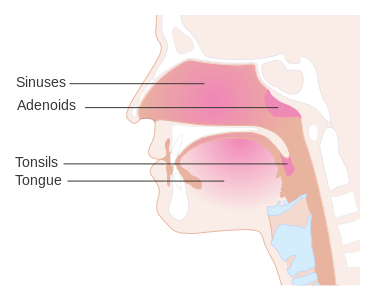Menu
Close
Back
Welcome to
Together is a new resource for anyone affected by pediatric cancer - patients and their parents, family members, and friends.
Learn MoreThe tonsils and adenoids are part of the body called the lymphatic system, which fights infections. The tonsils are in the back of the throat. The adenoids are higher up, behind the nose.

This illustration shows the location of the adenoids and tonsils. Used with permission of Cancer Research UK / Wikimedia Common.
Germs enter your child’s body through their mouth and nose. Tonsils and adenoids trap germs and protect your child from infection. Even though they fight infections, tonsils and adenoids can get infected too. One example is an infection like “strep throat.” Infections can:
Antibiotics are medicines that fight germs. These medicines usually heal a tonsil or adenoid infection. If your child gets these infections often or has breathing problems, they might need surgery. If your child has a certain number of infections over time, the surgeon may say your child needs a tonsillectomy, adenoidectomy, or adenotonsillectomy.
Surgery to remove the tonsils is a tonsillectomy. Surgery to remove the adenoids is an adenoidectomy. Your child’s doctor may remove either one. Sometimes, the doctor removes both at the same time in a surgery called an adenotonsillectomy. These are common surgeries.
If your child has a bleeding or clotting disorder, or another disease, then tell the surgeon before the surgery.
The surgery takes 30 minutes to one (1) hour. Plan to be at the hospital for about 5 or 6 hours. The surgery team will give your child general anesthesia. Your child will not be awake during surgery, will have no awareness, and will have no pain. The surgeon usually removes the tonsils, and your child does not need stitches.
After their surgery, your child will go to the hospital recovery room until they wake up. When your child wakes up and can drink clear liquids, you can take them home. Your child may need to stay 1 night or more at the hospital if they are:
Bleeding is one of the main risks of tonsil and adenoid surgery. Your child should not bleed a lot from the nose or mouth. Sometimes, they might have a small amount of slow bleeding from the nose. Please check on your child 1 or 2 times during the first night after surgery. If you have any questions, please call your primary or ENT clinic.
Your child will have severe (very bad) pain in their throat and ear sometime after surgery. Ear pain happens between Day 3 and 7 after surgery. This pain (known as referred pain) is from a nerve that goes to the tonsils and ears. This pain will be at its worst 5 to 7 days after surgery. This is the most important time to make sure your child is drinking plenty of fluids.
The doctor will give your child medications to reduce pain and help them feel more comfortable. Carefully follow your doctor’s instructions for giving pain medication for the first week after surgery. You can also reduce pain by:
Your child might have other side effects after surgery, such as:
Between 5 to 10 days after surgery, the scab breaks off when your child heals. When this happens, they might spit up bloody mucus. If the bloody mucous does not stop in a few minutes, take your child to the nearest emergency room.
Your child will be less active than usual for several days. They might have trouble falling asleep at night or not sleeping well. They should get back to normal in the next few days up to 2 weeks.
Start by giving your child clear liquids. Drinking plenty of liquid is important to prevent dehydration, or not having enough fluid in the body. While they are awake, give them small amounts of liquid every hour. Start with cool, clear liquids like:
This table shows you how much liquid your child should drink each day. The right amount depends on how much your child weighs. You can use a measuring cup, marked in ounces, to track how much they drink.
| If your child weighs this much ... | Drink at least this many ounces of liquid |
|---|---|
| More than 20 pounds | 34 ounces (oz.) |
| More than 30 pounds | 42 oz. |
| More than 40 pounds | 50 oz. |
| More than 50 pounds | 58 oz. |
| More than 60 pounds | 68 oz. |
If your child does not drink enough liquid, they may need to return to the hospital until they can drink enough.
If your child does not vomit or has a lot of pain, they can also try eating soft foods to start, like mashed potatoes or applesauce. They can move to a normal diet if they are not vomiting or having too much pain. But avoid sharp foods, like chips, pretzels, or crunchy food for 2 weeks after surgery.
Each child is different. Your child may go back to school when they eat a near normal diet and do normal activities (usually 7 to 10 days after surgery). They should avoid vigorous physical activity for 14 days after surgery as this can cause bleeding. Vigorous activity means running, jumping, rough play, riding a bike fast, or playing sports. Ask the doctor or nurse if you have questions about what your child can do.
If you have questions about your child’s tonsil or adenoid surgery, talk to the doctor, nurse, ENT, or your child’s primary clinic.
—
Reviewed: September 2022